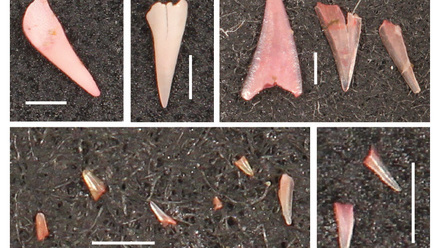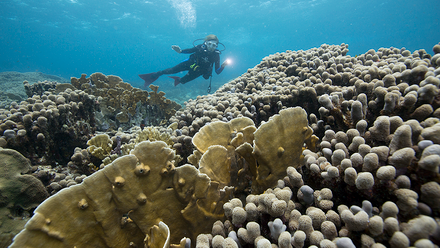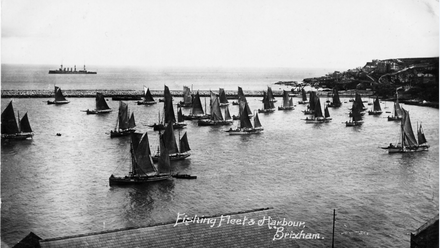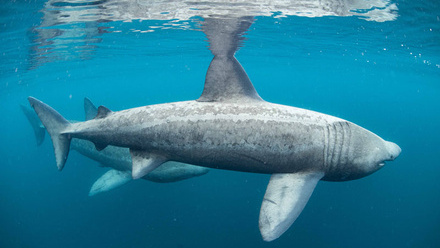Searching for River Monsters
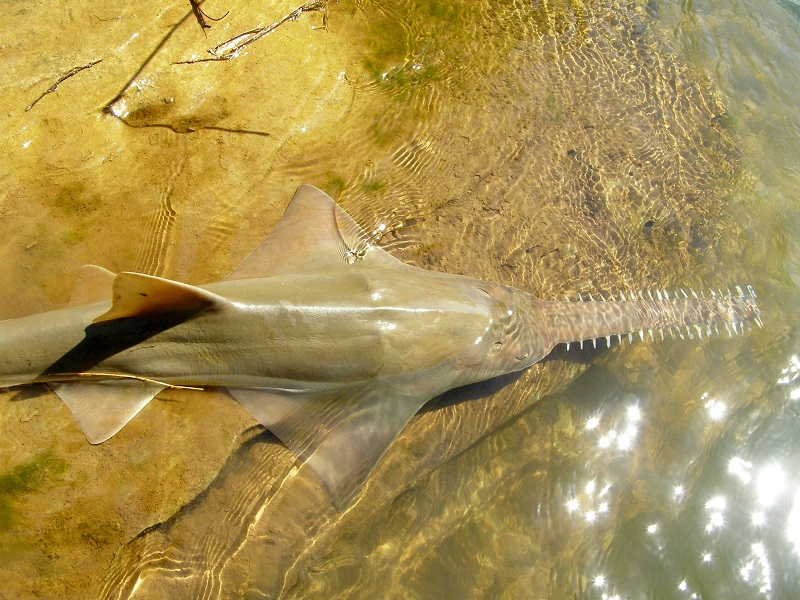
Above: Largetooth Sawfish. (Image: Miguel Clavero.)
Sawfishes are among the most bizarre and fascinating of all aquatic animals. They look like sharks, but are actually rays, and have a formidable, chainsaw-like rostrum or saw which can be up to one-quarter of the sawfish’s total body length. The rostrum is a highly sensitive structure, used to detect, stun and kill prey, which includes various fish, shrimp and other invertebrates living on or in the sediment. There are five species of sawfish, two of which—the Largetooth and Green Sawfish—can reach at least seven metres in length, making them the largest (or at least the longest) fish in the oceans after whale sharks and basking sharks. They are one of only a handful of shark and ray species that can live in both fresh and saltwater, and what little we know of the lifecycles of sawfishes suggests that they use a wide range of habitats—rivers, mangroves and estuaries as juveniles, coastal and offshore seas as adults.
Unbelievable though it may seem for such large and distinctive animals that are found in coastal areas and along rivers, close to human settlements, scientists still know remarkably little about the ecology and behaviour of sawfishes. What is clear is that, worldwide, sawfish populations have declined dramatically in recent decades, mainly due to the increased use of fishing nets (in which sawfishes become entangled, making them an easy target for fishers) and the loss of important habitats, especially mangrove forest. A recently-published study by scientists working for the Shark Specialist Group of the IUCN (International Union for the Conservation of Nature) determined that of all chondrichthyans (sharks, rays and chimaeras), the sawfishes are at greatest risk of extinction. Sawfishes were once widespread throughout the tropical and sub-tropical waters of the Atlantic, Indian and Pacific Oceans, with their ranges extending through the waters of at least 90 countries. Of these countries, at least 20 have now lost all of the sawfish populations formerly found there, and at least another 43 have lost one species of sawfish. This is based on the best available information, but for significant parts of their former range, basic up-to-date information on the persistence of sawfish populations is lacking. Nonetheless, the current distribution range of sawfishes is certainly a shadow of what it was several decades ago, and they can now be reliably found in only two strongholds: Florida, US, and Queensland and the Northern Territory, Australia.
In the face of such sombre findings, the IUCN in 2014 published a Global Conservation Strategy for sawfishes, outlining the steps that need to be taken to protect any remaining sawfish populations and to encourage recovery of depleted populations. Since this report was published, and motivated by the gaps in data, multiple research projects have sprung up to collect baseline information on sawfishes, particularly in many of the regions where information has until now been lacking – Africa, and South and Central America in particular. The findings of these projects are diverse.
Those in several West African countries such as The Gambia and Guinea- Bissau have confirmed the precipitous decline of sawfishes alongside a waning familiarity with sawfishes among local people. A similar decline has been reported from northern Peru, although several catches of adult Largetooth sawfish have occurred there in recent years. In contrast, sawfishes still appear to be caught with at least some regularity in parts of East Africa, and information currently being collected by numerous teams in Central America may too have surprises in store.

Above: Kuna “mola” applique cloth made by a female artist from the Guna Yala region of Atlantic coastal Panama. It depicts the sawfish, Sukku, which the Kuna people view as a special animal ally of mankind, protecting them from malevolent sea creatures in this world. (Image: Matthew McDavitt.)
It is hardly unexpected, given the imposing appearance of sawfishes, that they hold special significance in many traditional cultures around the world. A stylized image of a sawfish appears on all the bank notes and coins of the West African Franc (CFA), the currency of several West African nations, as it symbolizes prosperity and fecundity in the region. Sawfish rostra used to be placed on the roofs of houses in The Gambia and Senegal, to protect the inhabitants from accidents such as fire, or from evil spirits. In Guinea-Bissau, primarily in the Bijagós Archipelago, sawfishes are among the totemic animals symbolizing the forces of nature. They feature in the dances and ceremonies which are integral to the Bijagó culture, in which young men wear triangular headdresses which used to be topped with a real sawfish rostrum. Sawfishes are now so rarely encountered in Guinea-Bissau that a small saw carved from wood is now more commonly seen on these headdresses. In Panama, the Emberá and Wounaan peoples believe that sawfishes harboured powerful spirits, the assistance of which shamans would call upon during healing ceremonies, whilst the Kuna people believe that sawfishes are special protectors that will rescue them from drowning. The cultural importance of sawfishes to these and many other communities can be an important element to consider in developing conservation strategies.

Above: A Bijago Islander wearing a traditional headdress, topped with a wooden representation of a sawfish rostrum. (Image: Simon Wearne.)
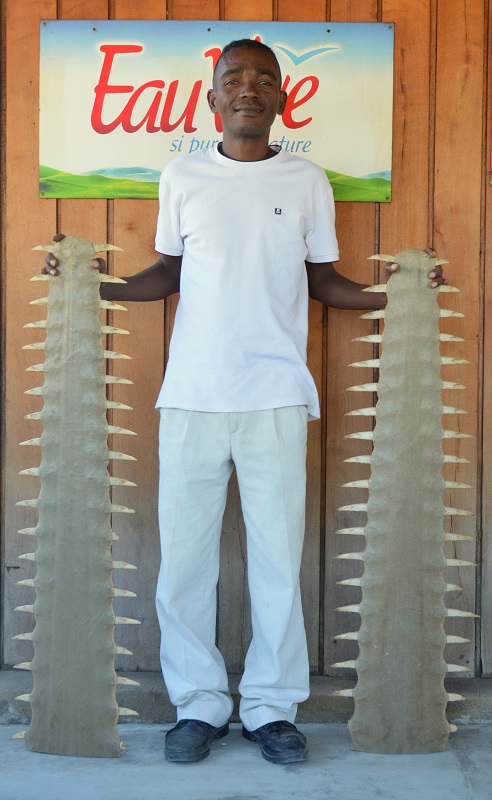
Above: Two Largetooth Sawfish rostra, both over a metre in length, from Madagascar. (Image: Ruth H. Leeney)
People are more likely to protect a species if it is a key part of their heritage or their traditional practices. By learning about these links between communities and their natural environment, conservationists and managers may be able to develop more locally-relevant, effective conservation strategies for sawfishes. This type of approach is synergistic, insomuch as the successful conservation of sawfishes in communities where they are culturally significant can in turn contribute to the conservation of those cultures, which are themselves, in some places, at risk of disappearing.
To my mind, there are two major hurdles currently facing sawfish conservation. The first is the lack of up- to-date information on where sawfish populations still exist and, as was mentioned earlier, a number of groups and projects are now tackling this chal- lenge. The second, far greater hurdle is that many of these remaining sawfish populations will invariably be located in developing countries, most likely in rural, hard-to-reach areas which are difficult to monitor. In such areas, human communities are often hugely reliant on fisheries in freshwater and coastal habitats as a means of survival, and anything a fisher catches is used as food or as a saleable commodity. If sawfishes are to be effectively protected in these areas, the conservation or management plan must take the needs of the nearby human communities into consideration, and must involve them in the process of developing and implementing the plan. Alternative ways for community members to produce food or earn money may need to be developed, so that they are less reliant on fishing, thereby removing the primary threat to sawfishes everywhere—the ubiquity of fishing nets. Raising awareness will be a key factor, to help communities understand why it is important to protect their local population of sawfish, and how they will benefit from doing so.
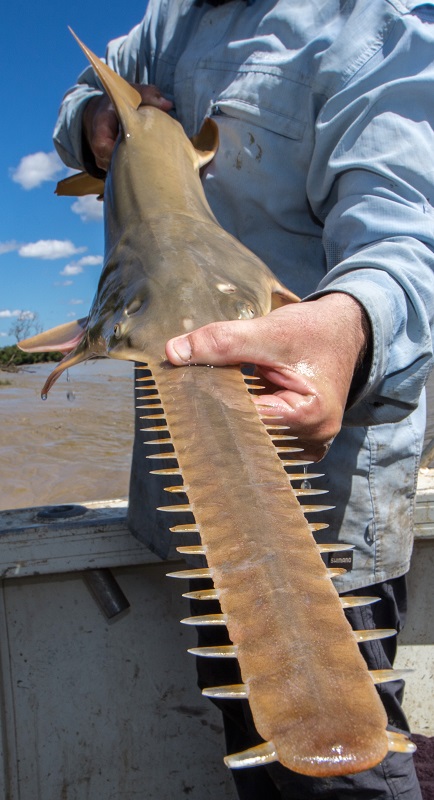
Above: Largetooth Sawfish (Pristis pristis) caught by researchers in Australia. (Image: Michael Lawrence Taylor.)
Ultimately, these programmes should aim to create a sense of stewardship for sawfishes within communities, and an understanding of the need for top predators as part of healthy marine and freshwater ecosystems.
Recent genetic studies have revealed fascinating insights into sawfish life his- tory and have significant implications for how the conservation of this group of endangered fish is approached. A study in Florida revealed that remark- ably, Smalltooth Sawfish can reproduce asexually. Using DNA fingerprinting, researchers showed that about 3% of the sampled sawfish population had apparently been created through female-only reproduction. The authors hypothesized that this type of repro- duction, known as parthenogenesis, may help depleted populations to maintain numbers during periods of rarity when encounters with members of the other sex were unlikely.
However, since this type of reproduction reduces the genetic diversity of the population and since all wild populations of vertebrates need genetic diversity in order to remain resilient to environmental changes, parthegenesis is certainly not going to save sawfishes and they still need urgent conservation—a means by which they can escape extinction in the longer- term. Research in northern Australia has shown that Largetooth sawfish in adjacent river systems are genetically distinct, meaning that female Largetooth sawfish (like salmon) are philopatric, returning to the same river they were born in, to give birth to their own pups. This implies that once a population in a certain river drainage has become extinct, it may be unrecoverable, since sawfishes in adjacent areas would be unlikely to move in to ‘new’ habitats to replenish depleted or locally extinct populations. All the more reason, then, to seek out and document any remaining sawfish populations, as soon as possible, before they invariably meet the same fate as have so many before. Once scientists and governments know where these extant populations are, they can begin to tackle the threats facing sawfishes in each area, to implement national legislation to protect the sawfishes and their habitats, and most importantly, to work closely with the communities in those areas to implement conservation measures. In other words, there is great potential to develop holistic, ecosystem-approach conserva- tion plans which can benefit not just sawfishes but also their riverine, mangrove and coastal habitats and the artisanal fishing communities that depend on those ecosystems.
Ruth Leeney (ruth.leeney@gmail.com) is a post-doctoral research fellow at Simon Fraser University, Canada, and is the Sawfish Conservation Officer for the IUCN’s Shark Specialist Group. She is the founder of Protect Africa’s Sawfishes, which has since 2012 conducted baseline surveys for sawfishes in five African countries.
Further reading
Harrison, L.R. and Dulvy, N.K. (eds). 2014. Sawfish: A Global Strategy for Conservation. IUCN Species Survival Commission’s Shark Specialist Group, Vancouver, Canada. ISBN: 978-0-9561063-3-9
Dulvy N.K., Davidson L.N.K., Kyne P.M., Simpfendor- fer C.A., Harrison, L.R., CARLSON J.K. and Fordham S.V.
Ghosts of the coast: global extinction risk and conservation of sawfishes. 2014. Aquatic Conservation: Marine and Fresh- water Ecosystems. DOI: 10.1002/aqc.2525
Fields et al. 2015. Facultative parthenogenesis in a Critically Endangered wild vertebrate. Current Biology 25: R439–R447. https://www.researchgate.net/publication/277558854_Faculta- tive_parthenogenesis_in_a_critically_endangered_wild_vertebrate
Want to find out more about sawfishes?
Visit the Sawfish Conservation Society’s website, where you can learn more about the different groups working to protect sawfishes worldwide, download printable species identification guides (in 5 languages) and even find games and children’s stories about sawfishes. www.sawfishconservationsociety. org
The IUCN Global Sawfish Conservation Strategy is available online: www.dulvy.com/global-sawfish-conservation-strategy.html


